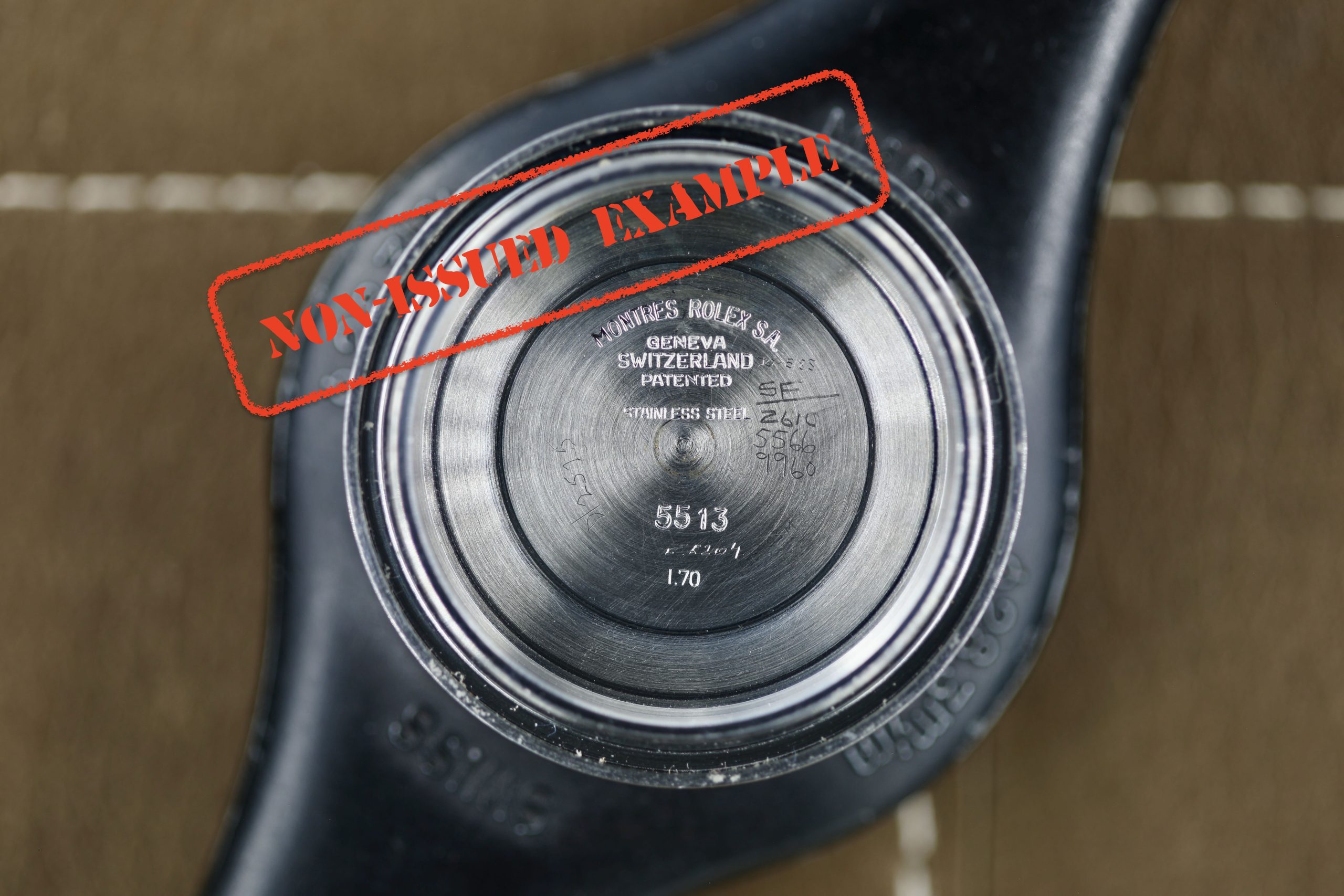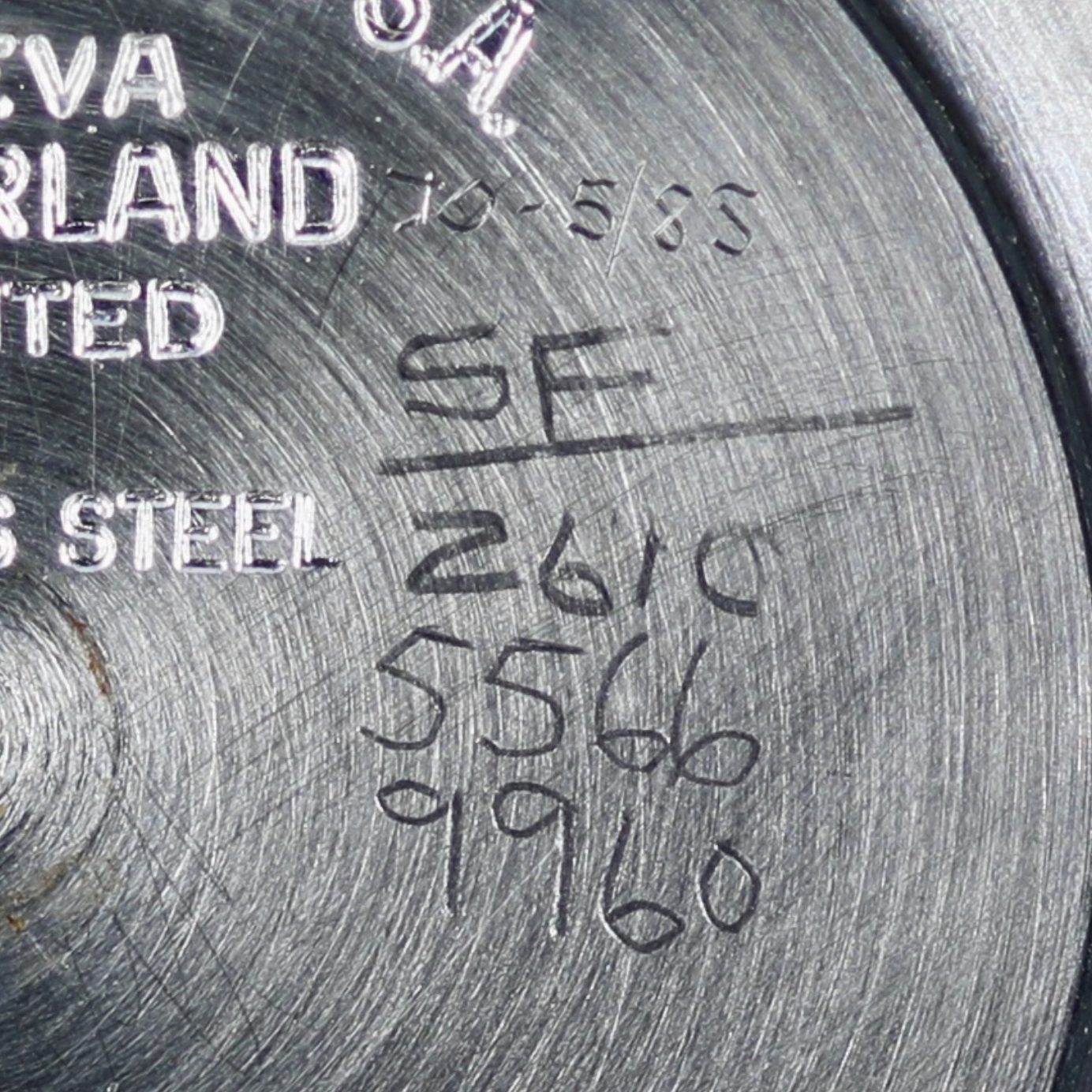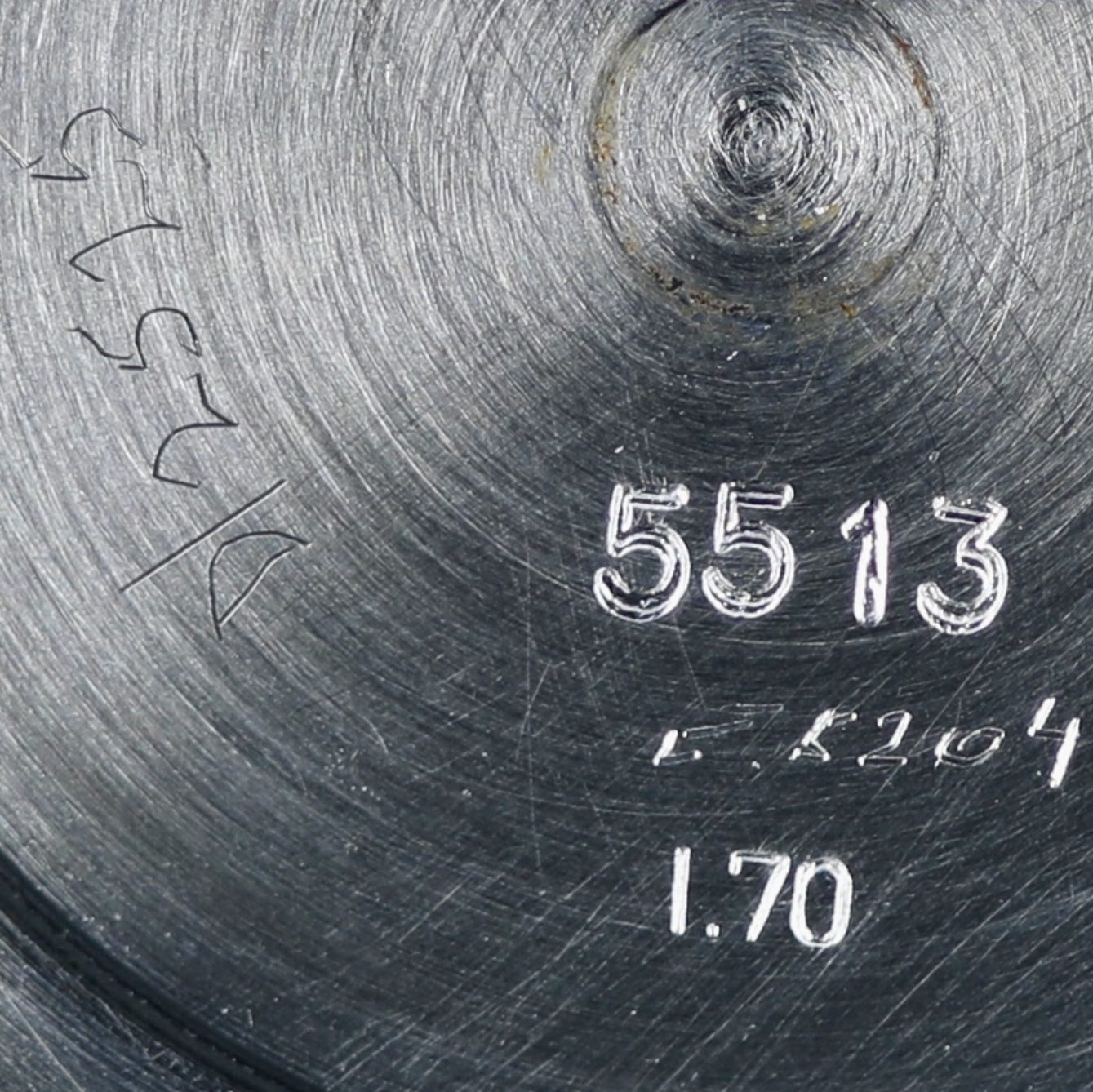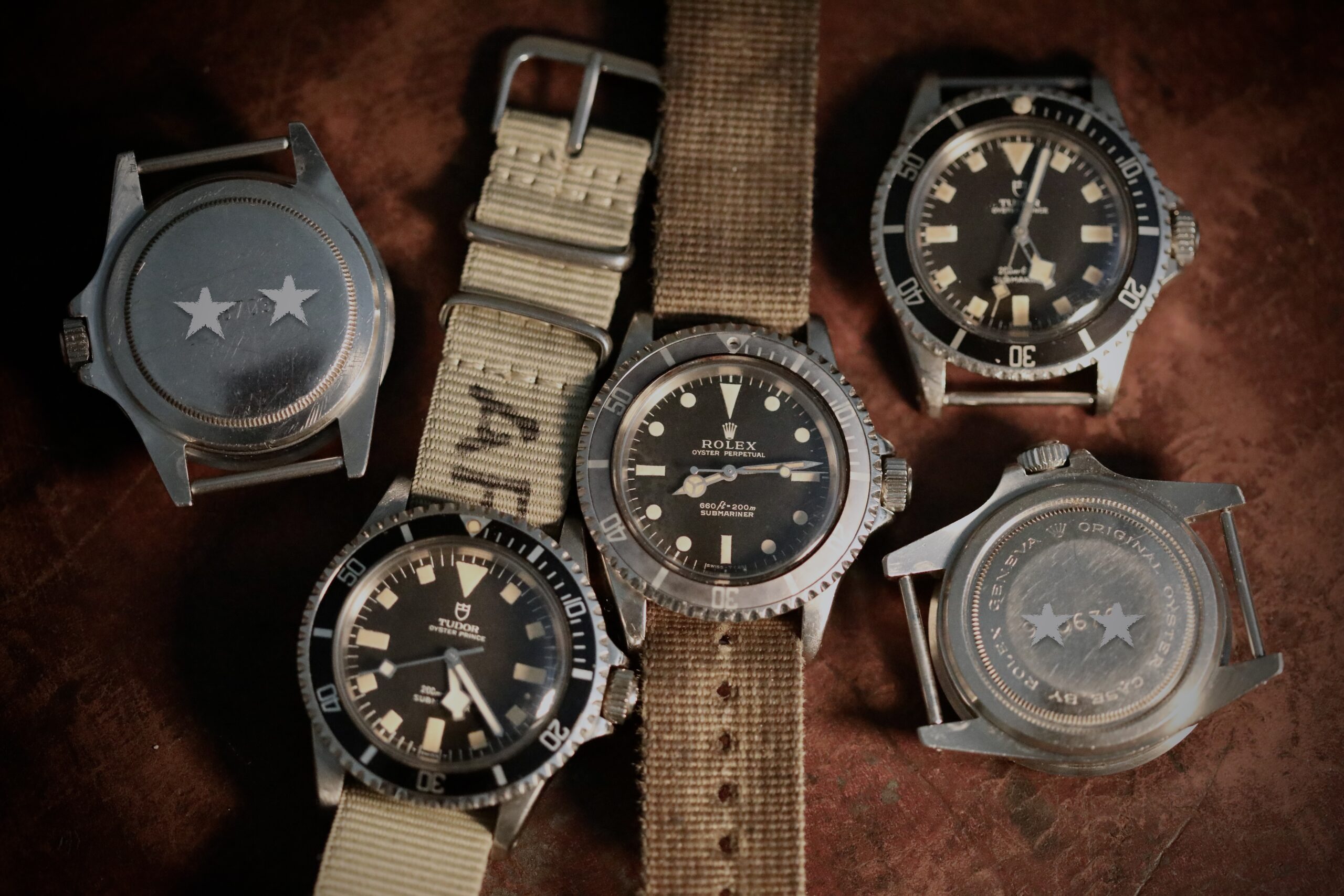An Analytical Report on South African Navy Military-Issued Tudor and Rolex Watches
Having spent the past few years hunting down South African Navy/ Army watches, i felt i needed to dig a little deeper and unlock some of the secrets that they held inside. At best, info is difficult to find, but when i decided to analyze the watchmakers service markings inside the watches……..they chose to give up a few more of their secrets.
For those who may not be aware, when a watchmaker services a watch he leaves a very lightly engraved “code” inside the watches caseback.This often includes an initial and a date of service, so as to have a record for himself or his department to refer back to should the watch be returned or serviced again. These can often be quite cryptic, and contain additional information like alpha numeric codes, and may also refer to a batch or a place of service.
I decided to put all this info from the 35 piece sample set into a spreadsheet and then use an analytics tool to look for patterns, dates and similarities across watches. The results were interesting to say the least!
Unfortunately, i need to remove the actual numbers from the report, but am happy to share with those who have an interest.



I. Executive Summary
This report provides a focused analysis of 35 military-issued Tudor and Rolex watches specifically associated with the South African Navy (SAN). A few of these ended up in the South African Army special forces units after tactical dive training by the Navy, but for this study we will just refer to them as SA Navy watches (SAN). The primary objective is to decipher patterns within their internal caseback service markings and to infer issuance quantities from their serial numbers. Key findings highlight the consistent and long-term involvement of “X” (a Simonstown watchmaker or facility) in servicing these timepieces, alongside the later, supplementary role of “Jo” (Rolex Johannesburg). A remarkable aspect is the extended operational life of these SAN watches, with service records indicating maintenance well into the 1990s and beyond, some even into the mid-2000s. Serial number analysis reveals distinct procurement batches for both Rolex and Tudor models, suggesting multiple, often small, acquisition events over time. This analysis underscores the SAN’s commitment to maintaining these precision instruments as vital, long-term assets.
II. Introduction to South African Navy Military-Issued Watches
From the early 1960s, robust and reliable wristwatches, particularly dive watches, became essential equipment for naval forces. The South African Navy, recognizing the critical role of precision timekeeping in its operations, procured watches from renowned manufacturers like Rolex and Tudor. These timepieces were not merely accessories but crucial tools for navigation, timing operations, and ensuring the safety of divers in challenging underwater environments. Their integration into the SAN’s inventory underscores a recognition of their functional importance, necessitating consistent accuracy and resilience in extreme conditions.
This report conducts a meticulous, data-driven analysis of a specific dataset of 35 military-issued watches exclusively linked to the South African Navy. The primary aim is to uncover underlying patterns in their service history and procurement, with a particular emphasis on the distinct maintenance protocols evidenced by their internal caseback markings. The dataset encompasses Rolex Model 5513 and Tudor Models 7016 and 94010, offering a rare glimpse into the lifecycle management of these specialized military assets within the SAN.
III. Overview of the South African Navy Dataset
The dataset under examination comprises 35 individual military-issued watches specifically attributed to the South African Navy, providing a foundation for a quantitative and qualitative assessment of their distribution and historical records.
Distribution by Brand and Model
Within the SAN sample, 13 watches are identified as Rolex Model 5513. The remaining 22 watches are Tudor models, consisting of 19 Tudor Model 7016 and 5 Tudor Model 94010. This distribution indicates that the SAN procured both Rolex and Tudor watches for its operational needs, with a slightly higher number of Tudor watches in this specific sample. The presence of two distinct Tudor models (7016 and 94010) suggests an evolution in procurement or a phased acquisition of newer models over time.
Initial Observations on Data Completeness
A significant proportion of the South African Navy watches exhibit rich, albeit often complex and unstructured, service markings on their casebacks. While some data entries are marked “Information not available,” the majority provide valuable insights into their maintenance history. This contrasts with other military-issued watches not in the SAN inventory, which often lack such detailed records. The presence of these internal engravings is crucial for understanding the SAN’s approach to equipment longevity and record-keeping.
IV. Analysis of Service Record Markings: Deciphering the Inside Caseback
The internal caseback engravings on military-issued watches serve as a unique historical ledger, documenting their operational life and maintenance history. These markings are often unstructured, abbreviated, and at times cryptic, comprising a mix of alphanumeric codes, dates, and non-standard characters. This analysis focuses on interpreting the user-provided keys: “X” for the Simonstown watchmaker/facility and “jo” for Rolex Johannesburg.
The “X” Markings (Simonstown Watchmaker)
The “X” marking, representing the Simonstown watchmaker or a dedicated naval servicing facility, is prominently featured on several South African Navy watches. It appears on 7 out of 13 Rolex 5513 watches (Samples 2, 3, 6, 8, 10, 12, 13) and 1 out of 19 Tudor 7016 watches (Sample 31).
A chronological analysis of the dates associated with “X” markings reveals a significant span of activity. The earliest “X” service recorded is September 1961 (on Rolex 5513, Sample 12), and the latest is August 1980 (on Tudor 7016, Sample 49). This extensive chronological range, covering nearly two decades (1961-1980), strongly indicates that the Simonstown watchmaker, or the entity represented by “X,” served as a consistent and dedicated in-house or primary local naval servicing entity for these watches. This period covers their initial operational phase and extends well into their service life, suggesting a robust and established maintenance capability within the South African Navy’s operational infrastructure. The continuity of service points to a well-resourced and strategic approach to equipment longevity, likely involving a dedicated naval base workshop.
Furthermore, some watches exhibit multiple “X” markings, providing direct evidence of recurring service events. For example, Rolex 5513 (Sample 3, serial xxx1532) shows two distinct “X” entries: (August 1973) and (November 1977). 1 This observation confirms that “X” was engaged not merely in initial inspections or one-off repairs, but in ongoing, routine upkeep. This practice is crucial for maintaining the operational readiness and extending the lifespan of precision military equipment, indicating a structured maintenance program, either based on fixed intervals or on an “as-needed” basis, ensuring the watches remained functional over time.
The “Jo” Markings (Rolex Johannesburg)
The “Jo” marking, representing Rolex Johannesburg, appears on a smaller subset of South African Navy watches, specifically on two Rolex 5513 examples (Samples 6 and 7). The dates associated with these markings are Jo 8/95 (August 1995) and Jo5/96 (May 1996).
These “Jo” markings appear exclusively in the mid-1990s, significantly later than the latest “X” dates. This distinct chronological separation strongly suggests a shift in the servicing strategy for the South African Navy, or a supplementary role for Rolex Johannesburg. Another possibility, due to the fact that post 1990 watches were no longer issued in the SAN, that these were serviced privately when no longer in SAN stock. There is a gap of over a decade where no “X” or “Jo” service is explicitly recorded, followed by the emergence of “Jo” markings. This implies a transition in the maintenance ecosystem. “X” likely handled the earlier, routine, and possibly in-house services, while “Jo,” as the official brand representative, might have been engaged for more complex overhauls, parts replacement (especially as original parts became scarce), or when the watches reached a certain age requiring factory-level attention. This indicates an adaptive and evolving maintenance strategy for long-serving military assets. The “XX” marking (e.g.on Tudor 7016 Sample 32, and on Tudor 94010 Sample 60) also appears in the mid-1990s, suggesting a continuation or evolution of the Simonstown-based servicing, possibly under a slightly different designation or expanded scope.
Other Significant Service Markings and Codes
Beyond “X” and “Jo,” the service records of South African Navy watches contain a pervasive presence of additional, cryptic alphanumeric codes, such as “xx”, “x-series”, “y-series”, “z-series”, and “xx”. Examples include “xxxxx” (Sample 2), “xxxx” (Sample 2), “xxxx” (Sample 3), “xxxxxx” (Sample 6), “xxxxx” (Sample 7), “xxxx” (Sample 10), “xxxxxx” (Sample 48), and “xxxx” (Sample 58). While their precise meaning remains unconfirmed without external documentation, their consistent appearance across multiple watches indicates a structured internal coding system. This system was likely used for various types of repairs, inspections, or component replacements, reflecting a highly detailed, bureaucratic, and standardized internal record-keeping system within the South African Navy’s maintenance operations. These codes likely represent specific types of work performed (e.g., “x” for adjustments, “xx” for specific part numbers or technical notes), internal departmental identifiers, or even individual technician codes. This level of granular detail reflects a comprehensive and systematic approach to managing and tracking the life cycle of these valuable military assets, signifying a strong emphasis on accountability, traceability, and perhaps even performance tracking of repairs.
Chronological Span of Service for South African Navy Watches
Synthesizing all extracted dates from the service markings reveals a remarkably long timeline of maintenance activities for South African Navy watches. The earliest observed service date is September 1961 (xxxxx on Rolex 5513, Sample 12), while the latest is November 2006 (xxxxx on Tudor 94010, Sample 35). Other notable late dates include November 8, 2004 (xxxxx on Rolex 5513, Sample 6) and May 2005 (xxxxx on Rolex 5513, Sample 12).
The observed service span of 45 years (from 1961 to 2006) for South African Navy watches is an exceptional testament to the inherent durability of Rolex and Tudor timepieces. More critically, it highlights the sustained commitment of the South African Navy to their maintenance and continued operational deployment. This remarkable longevity implies that these watches were considered vital, long-term assets, justifying significant ongoing investment in their upkeep. This extensive period for mechanical watches, especially in a harsh naval environment, is highly unusual and speaks to a “repair-and-sustain” philosophy rather than a “replace-when-worn” approach. This suggests either budgetary constraints necessitating prolonged use of existing assets or a deep appreciation for the quality and reliability of these specific watches, making them worthy of continuous investment.
V. Serial Number Analysis: Issuance Quantities and Batch Identification
The analysis of serial numbers is crucial for inferring procurement patterns and estimating issuance quantities, particularly given the user’s guidance that “big gaps in serial numbers most likely means separate smaller batches.” The approach involves identifying contiguous or near-contiguous blocks of serial numbers within each brand, treating significant numerical discontinuities as strong indicators of separate procurement events or distinct manufacturing runs.
Rolex South African Navy Serial Numbers
The Rolex 5513 watches issued to the South African Navy exhibit serial numbers that fall into distinct numerical clusters.
- Batch 1 (Early 1.1M – 1.2M series): This group includes serial numbers xxx4741, xxx1518, and xxx1532. This represents a small, likely early procurement.
- Batch 2 (Mid-2.5M – 2.8M series): This larger group encompasses serial numbers xxx7034, xxx8137, xxx3743, xxx3016, xxx3053, xxx8642, xxx0326, xxx0327, xxx5055, and xxx5074. This appears to be a larger, and chronologically later, procurement.
The clear numerical separation of Rolex serial numbers into at least two distinct ranges (approximately 1.1-1.2 million and 2.5-2.8 million) provides compelling evidence of at least two but likely 5 separate procurement orders by the South African Navy for their Rolex 5513 watches. The substantial gap of over 1 million units between these clusters indicates distinct acquisition periods. The presence of a larger, later batch suggests an increased demand, a planned replacement cycle, or a strategic expansion of their dive watch inventory over time. This implies that the SAN did not acquire all its Rolex 5513s in one single large order but rather through multiple distinct purchasing phases, likely years apart, reflecting evolving operational needs, budget availability, or perhaps even a phased integration of these watches into service.
Tudor South African Navy Serial Numbers
Tudor watches issued to the South African Navy are represented by two distinct models, each corresponding to a specific serial number range, indicating separate procurement phases.
- Batch 1 + 2 (Tudor 7016 Model, 827xxx series): This forms a relatively tight numerical cluster, representing an acquisition and top up of the 7016 model.
- Batch 3 (Tudor 94010 Model, 930xxx series): This constitutes a numerically distinct and chronologically later cluster, corresponding to the acquisition of the newer 94010 model.
The clear segregation of Tudor serial numbers by model (827xxx series for Model 7016 and 930xxx series for Model 94010) confirms at least two distinct procurement phases for Tudor watches by the South African Navy. This pattern strongly suggests a planned upgrade path or successive procurement of newer model generations as they became available. This indicates a continuous interest in Tudor dive watches and an evolution in their equipment standards, implying that the SAN either phased out the older 7016s for the newer 94010s, or simply acquired newer models as they became available, demonstrating a sustained commitment to equipping its personnel with contemporary dive watches.
Estimated Issuance Quantities
Based on serial number clustering and gaps:
Rolex 5513 Batches:
- Batch 1: ~15-20 watches
- Batch 2: ~25-30 watches
- Batch 3: ~10-15 watches
- Total Rolex estimate: 50-65 watches
Tudor 7016:
- Primary batches: ~40-50 watches (based on 633 serial span with gaps)
- Total Tudor 7016 estimate: 40-50 watches
Tudor 94010:
- Single small batch: ~10-15 watches
- Total Tudor 94010 estimate: 10-15 watches
Overall Program Estimate: 100-130 military watches issued across all batches
VI. Key Observations and Implications
The analysis of this unique dataset yields several significant observations regarding the procurement, maintenance, and operational lifespan of military-issued Tudor and Rolex watches within the South African Navy.
Distinct Service Philosophy and Record-Keeping
The South African Navy’s detailed, multi-decade service history, meticulously engraved on casebacks, points to a highly rigorous, individualized, and transparent system for tracking equipment provenance and maintenance history. 1 This likely reflects a high perceived strategic importance of these watches and a distinct military-logistical doctrine emphasizing on-item record-keeping. This practice is a hallmark of a well-organized and accountable asset management system.
Remarkable Longevity and Consistent Servicing
The observed service span of 45 years (from 1961 to 2006) for South African Navy watches is an extraordinary testament to both the inherent durability and quality of Rolex and Tudor mechanical movements. Crucially, it also highlights the sustained commitment of the South African Navy to their maintenance and continued operational deployment. This remarkable longevity implies that these watches were considered vital, long-term assets, justifying significant ongoing investment in their upkeep.
The evolution of the maintenance ecosystem is also apparent: the “X” (Simonstown) entity appears to have been the primary, long-term, and likely in-house or local servicer during the watches’ earlier life (1961-1980). This function transitioned or was supplemented by “Jo” (Rolex Johannesburg) for later-stage or more specialized external servicing (mid-1990s). This indicates a pragmatic and multi-tiered maintenance approach designed to maximize asset lifespan. The significant and prolonged investment in servicing these watches underscores their critical operational value to the SAN and their commitment to maintaining equipment readiness, highlighting the economic and practical advantages of repairing high-quality mechanical assets over frequent replacement.
Correlation between Serial Number Batches and Service Marking Patterns
A notable correlation exists between the identified distinct serial number batches and the chronological progression of service markings. For instance, watches from earlier Rolex 5513 serial number batches (1.1M-1.2M series) and early Tudor 7016 batches (827xxx series) predominantly feature older “X” dates. Conversely, later batches or models, such as the Tudor 94010 (930xxx series), show a higher incidence of “Jo” or later service dates, aligning with the observed shift in service providers over time. This observed correlation validates the batch identification methodology and provides a more comprehensive lifecycle narrative for these watches, linking their initial acquisition to their subsequent long-term maintenance history. It allows for a more nuanced understanding of how different procurement periods might relate to subsequent service demands or changes in maintenance providers.
VII. Conclusion
This focused analysis of 35 military-issued Tudor and Rolex watches from the South African Navy provides substantial insights into their procurement and maintenance histories. The distinct service record patterns observed, marked by the long-term involvement of “X” (Simonstown) and the later, specialized contributions of “Jo” (Rolex Johannesburg), underscore a robust and evolving maintenance infrastructure. The remarkable 45-year service span of these watches (1961-2006) is a testament to their inherent quality and the SAN’s sustained commitment to their operational readiness.
Serial number analysis successfully delineated distinct issuance batches for both Rolex and Tudor watches within the SAN. The SAN procured Rolex 5513s in at least two major batches and Tudor watches in two phases corresponding to model generations (7016 and 94010). This pattern of multiple, often smaller, batches aligns with the understanding that these were acquired in limited quantities over time.
For collectors and researchers, these findings underscore the immense value of internal caseback markings as a primary source of provenance and historical data for military watches, especially for South African Navy examples. The identified service patterns, procurement batches, and qualitative insights contribute significantly to a deeper, more nuanced understanding of military procurement, logistical support, and maintenance strategies for precision timepieces. Further research could focus on deciphering the specific meanings of the various alphanumeric codes (e.g., xx, X-series) found on SAN watches and exploring the broader historical context of South African naval watch procurement policies to corroborate and expand upon these data-driven inferences.



One Response
Please feel free to comment…..your feedback is always appreciated.